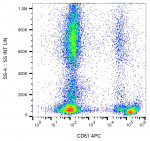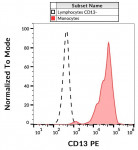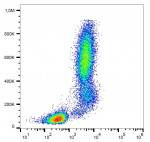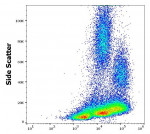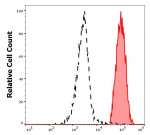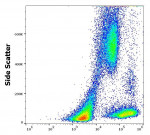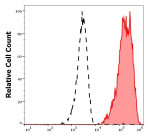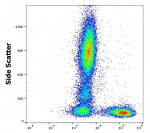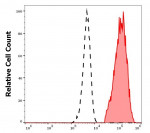Search Result - Primary Antibodies
There are 1231 results for "Glycoprotein"
- anti-CD61 / Integrin beta 3 antibody [VIPL2] (APC)
- Cat. No: ARG54306 (Mouse mAb)
- Reactivity: Hu, NHuPrm
- Application: FACS
- Specificity: The clone VIPL2 recognizes CD61, a 90-110 kDa transmembrane glycoprotein of integrin family, expressed on platelets, megacaryocytes, osteoclasts, endothelial cells and other cell types, including leucocytes and smooth muscle cells.
HLDA V.; WS Code 5T-124 - Conjugation: APC
- anti-CD13 antibody [WM15] (PE)
- Cat. No: ARG54311 (Mouse mAb)
- Reactivity: Hu, NHuPrm
- Application: FACS
- Specificity: The clone WM15 recognises the human CD13 cell surface glycoprotein, a 150 kDa molecule expressed on granulocytes, endothelial cells, epithelial cells and myeloid progenitors.
HLDA III; WS Code M 213
HLDA IV; WS Code M 44
HLDA IV; WS Code M 209
HLDA V; WS Code M MA191 - Conjugation: PE
- anti-CD13 antibody [WM15] (PerCP)
- Cat. No: ARG54312 (Mouse mAb)
- Reactivity: Hu, NHuPrm
- Application: FACS
- Specificity: The clone WM15 recognises the human CD13 cell surface glycoprotein, a 150 kDa molecule expressed on granulocytes, endothelial cells, epithelial cells and myeloid progenitors.
HLDA III; WS Code M 213
HLDA IV; WS Code M 44
HLDA IV; WS Code M 209
HLDA V; WS Code M MA191 - Conjugation: PerCP
- anti-CD13 antibody [B-F10]
- Cat. No: ARG56025 (Mouse mAb)
- Reactivity: Hu
- Application: FACS, ICC/IF, IHC-Fr
- Conjugation: Un-conjugated
- anti-CD11a / LFA1 alpha antibody [DF1524]
- Cat. No: ARG56041 (Mouse mAb)
- Reactivity: Hu
- Application: FACS, ICC/IF, FuncSt
- Conjugation: Un-conjugated
- anti-CD53 antibody [63-5A3]
- Cat. No: ARG56100 (Mouse mAb)
- Reactivity: Hu
- Application: FACS, ICC/IF, FuncSt
- Conjugation: Un-conjugated
- anti-ABCB5 antibody
- Cat. No: ARG56227 (Rabbit pAb)
- Reactivity: Hu
- Application: FACS, WB
- Conjugation: Un-conjugated
- anti-CD11a / LFA1 alpha antibody [MEM-25]
- Cat. No: ARG62707 (Mouse mAb)
- Reactivity: Hu
- Application: FACS, IP, FuncSt
- Specificity: The clone MEM-25 reacts with CD11a (alpha subunit of human LFA-1), a 170-180 kDa type I transmembrane glycoprotein expressed on B and T lymphocytes, monocytes, macrophages, neutrophils, basophils and eosinophils.
HLDA IV; WS Code NL 209 - Conjugation: Un-conjugated
- anti-CD11a / LFA1 alpha antibody [MEM-83]
- Cat. No: ARG62708 (Mouse mAb)
- Reactivity: Hu
- Application: FACS, IP, FuncSt
- Specificity: The clone MEM-83 reacts with CD11a (alpha subunit of human LFA-1), a 170-180 kDa type I transmembrane glycoprotein expressed on B and T lymphocytes, monocytes, macrophages, neutrophils, basophils and eosinophils.
HLDA IV; WS Code N 211 - Conjugation: Un-conjugated
- anti-CD3 epsilon antibody [OKT3] (low endotoxin)
- Cat. No: ARG62801 (Mouse mAb)
- Reactivity: Hu
- Application: FACS, IHC-Fr, FuncSt
- Specificity: The clone OKT3 recognizes the CD3 antigen of the TCR/CD3 complex on mature human T cells. This antibody, also known as Orthoclone OKT3 or Muromonab-CD3, has been extensively used as a drug for therapy of acute, glucocorticoid resistant rejection of allogenic renal, heart and liver transplants. It has also been investigated for use in treating T-cell acute lymphoblastic leukemia.
HLDA VI; WS Code T6T-R3 - Conjugation: Un-conjugated
